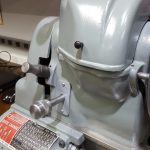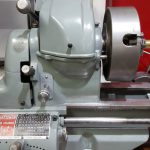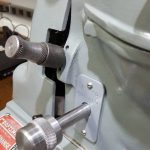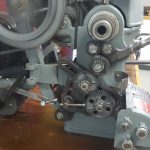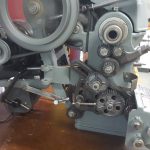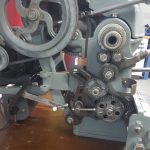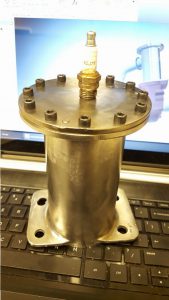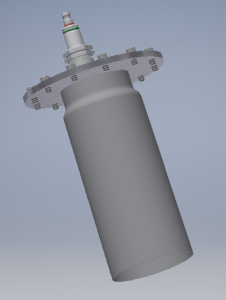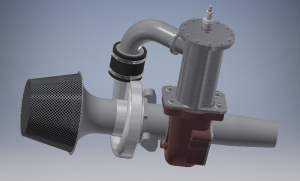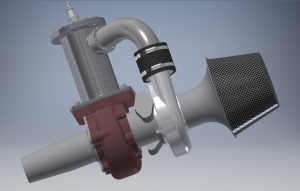-
Recent Posts
Recent Comments
Category Archives: Uncategorized
Bus Engine Rebuild
A slight change of direction with the transmission rebuild. I was looking forward to going through the transmission and readjusting everything to make it work again, but to get more speed I would have needed to swap out the ring/pinion gear as well as 4th gear. The cost for these gears separately was not too much different from the cost of a rebuilt transmission that included these gears. Because of this, there’s a rebuilt transmission on the way that already has the ‘correct’ gearing. Since this is a hobby I normally don’t think about time too much, but this also buys me a lot of time that gives me a chance to instead go through the engine while I’m waiting for the transmission to arrive.
I started going though the engine this weekend. There wasn’t anything necessarily ‘wrong’ with it, but it was put together somewhat hurriedly prior to having the bus at the wedding; I’ve since had a chance to second-guess a few things I did, especially with balance. I stripped it down to the case and this time gave it thin coat of black paint; heat has been an ongoing issue and changing the color to flat black will actually improve heat dissipation slightly. Overall everything looked good, bearing wear looked normal.
VW Bus Transmission – The Sequel
This weekend I finally pulled the engine and transmission from the bus – each time I’ve done this I’m amazed at how few connections there are and how relatively quickly it goes. The goals for this effort are to figure out what happened that caused the breakdown last year as well as fix the problems that had been occurring since the original ‘rebuild’ (more of a clean and reseal). These problems included:
- Immediate pop out of 1st gear and inability to hold in gear. This effectively meant no 1st gear, requiring always starting in 2nd gear.
- 4th gear popped out under load, but could be held in place by a bungee cord. This worked, but is a really inconvenient way to drive and would eventually cause excess wear on the shift forks and slide gears.
- Gear oil leaking from center. This should be an easy fix, I didn’t originally realize the paper gaskets used for the reseal were not treated; using gasket sealer this time should solve this problem.
- Too slow. Currently the bus red-lines in 4th gear somewhere in the low-to-mid 60MPH range, which mostly rules out interstate travel. More flexibility to do longer trips and even to more easily run errands locally would be nice to have. The engine is a little bigger than stock and should be able to handle the higher load, but gearing changes will be needed to get the RPM’s down.
I started disassembly and found that the internals seem to be in incredibly good shape, the teeth show little or no wear even looking under a microscope. All the gear ratios match what would be expected for a ’67 bus except 4th – for some reason it has a 0.88 ratio rather than the 0.82 ratio that would be expected. The 0.88 4th gear would be consistent with a beetle transmission, so I think this information combined with the amazing internal condition tells me that the transmission was replaced with a new or re-manufactured beetle transmission (while keeping the bus axles and reduction boxes) at some point very late in the bus’s history. The top speed would have dropped dramatically after this change and perhaps this contributed to it being parked semi-permanently in the early 80’s.
Jet Engine Update
The jet engine combustor is now mostly complete, all that’s left for it is to #1 drill/tap for the spark plug and fuel injector(s) and #2 add an intake duct for compressor air. I’ve also mostly completed the 3D model – there aren’t many straight lines or surfaces on it, remembering all the 3D modeling tricks to make this was a lot of fun. I even went a bit overkill with the model – I may not actually build a bell mouth intake, screen, and/or jet tube.
The biggest looming challenge is deciding on a hole pattern for the flame tube. It’s critical that the flame tube holes are in the right places to correctly ‘hold’ the flame through various engine speeds, particularly while starting. If there are too many holes the air will mix too readily and the flame will be blown out, not enough holes and the engine will starve for air and not achieve self-sustaining operation. This is the biggest area for experimentation on the system and it’s why I made the flame tube easily removable from the combustor, modifications may need to be made.
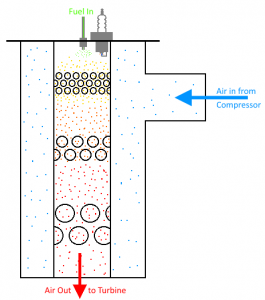
Beyond that, everything else is just basic design, fabrication, plumbing, and wiring:
- Finish 3D module including stand w/ various support systems
- Oil system (Oil tank, oil pump, electric motor)
- Fuel system (This will be propane at first for simplicity and safety, but provisions may be made for future use on Diesel/Kero/JetA)
- Starting system (Air jet strategically aimed at compressor wheel)
- Ignition system (old ignition coil excited by a power transistor pulsed by the control system)
- Electrical design, construction, and programming for instrumentation & control system (tachometer, temperature sensors, etc)
Broken Bus
Today as I was backing the bus into a parking place, the clutch pedal suddenly became unusually light. It did not stall as I slowed down, so the clutch wasn’t stuck engaged – however once pulled out of gear it would not go back in while running, meaning the clutch was at least partially engaged.
I’ve always thought of the engine/transmission that are in the bus as temporary – I didn’t do much to these other than disassemble, clean, and reassemble. As such, there have been one or two roadside repairs needed, but I’ve always been able to MacGyver it well enough to avoid a tow. That wasn’t the case this time and I had to have it towed a few miles back home.
It’s not a problem with anything I can see on the outside (pedal/cable/fork), so instead something has occurred somewhere inside the transmission. I didn’t hear any pops or bangs, so likely it’s something along the lines of a bent clutch fork. I’ll pull the engine/trans over winter to both find out the problem and also rebuild for more speed, less noise, etc.
Gas Turbine!
Before anyone gets excited, this is in reference to BUILDING a gas turbine (jet) engine rather than flying one, but it should be almost as much fun…
I’ve had a gas turbine (jet) engine on my ‘some day’ projects list for a long time. While cleaning the shop the other day I realized that I now have basically everything needed to complete this: a spare turbocharger, old oil pump, numerous microcontroller demo boards, various switches & sensors, scrap metal, and an assortment of plumbing fittings. All that’s needed to make it happen is to design and build it – a fun ‘free’ project.
I started on the combustor tonight. Fabrication should be generally easy compared to the CNC machine build, however without a lathe or mill there are some parts that I will have to fabricate creatively. I have jumped the gun a bit in not designing digitally first. In general the design will consist of wild guesses based on other similar projects online; so I haven’t lost out on anything by not having a digital model first, but I will create one as I go to make future changes easier to understand.















